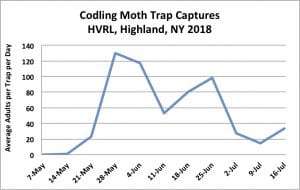Synopsis: Significant injury to Hudson Valley tree fruit has been observed over the past few seasons from 1st generation codling moth (CM) larva. In our untreated blocks we’ve observed 31% injury from 1st generation codling moth (CM) in Ginger Gold fruitlets this season. The second generation of CM has started this week with the 12th of July as the biofix date for the HVRL.
Codling moth and apple maggot flights are on the increase in regional traps last week. Biofix for the 2nd generation CM flight was on the 13th of July. First hatch of 2nd generation CM larva is expected at the HVRL on the 22nd of July. Orchards that have fruit injury from first generation CM this season and or are adjacent to infested or newly abandoned orchards will require management beginning at early hatch. Timing, use of most effective materials, employing effective rates and incorporating resistance management strategies are becoming more important to obtain effective codling moth control.

Overview: We are approaching the 2nd of possibly 3 codling Moth generations next week, requiring management in Hudson Valley commercial orchards. Many of the regions apple orchards now have resident (endemic) populations of codling moth residing in their orchards from infestations occurring over the past few seasons. Assessing fruit injury from the 1st generation of codling moth by scouting for frass at the calyx and stem end of fruit is critical for mid-late season pest management decision making.
Focus on specific blocks where specific variety fruit injury was observed last season. Remove suspect fruit and slice through the center to look for seed feeding indicating codling moth larva presence. If codling moth injury is observed in fruit, management is required to reduce further injury during 2nd generation larval emergence.
We have passed the window for use of pheromone trapping to capture the initial wave of second generation CM adults to establish on-farm biofix in the mid-Hudson Valley. As such, are too late to effectively control this second generation CM through mating disruption unless it was applied earlier in the season. The use of Rimon 0.83EC is most effective prior to egg laying, which too has come to pass and would be less effective applied for control of CM. We are now left with the remaining options for managing this insect using contact and feeding insecticides including granulosis virus.

In the mid-Hudson Valley, larval emergence will occur during the latter part of this week, requiring management in blocks with historical damage or adult trap capture exceeding >5 CM adults per week. Maintaining residue of effective insecticide on a 2 week schedule based on weather.
A number of products are available for use in New York State. In blocks of high fruit infestation from codling moth in 2016, a possible cause may have been the use of materials ineffective against the worm during the three generation emergence periods of the larval stage, most notably the 3rd generation in September. The possibility of frequently used insecticides slipping in efficacy is also a possibility.
This insect continues to re-emerge as a primary pest of apple throughout the world. And it can be argued that codling moth has historically been the greatest threat to tree fruit production due to its endemic orchard presence, constant exposure and development of cyclical resistance to insecticide programs. During the 2016 harvest we observed very high levels of fruit infestation in Hudson Valley apple, ranging from 2% to 40% injury in commercial production, bringing a level of uncertainty to the effectiveness of the materials in our toolbox.
Management: Presently we have standard ‘older’ classes of insecticides that include the Organophosphate, Carbamates, Pyrethroids and Pyrethroid pre-mixes that are still effective along with the Neonicotinoid Assail, Anthranilic Diamides that include Altacor and Exirel, and Spinosyns including organic Entrust and conventional insecticide Delegate.
An additional option is to apply a granulosis virus formulation at 200-250 DD 50°F. High moth pressure requires 2-3 sprays for the first generation, but in lower pressure orchards (with counts of less than 5 moths per trap per week), you can control CM with a single spray timed at 350 DD 50°F.
Codling moth granulosis virus formulations include Cyd-X, Cyd-X HP, Madex HP by Certis; Carpovirusine by Arysta LifeScience. Cyd-X 0.06SC is applied @ 0.25-0.4 qt/acre and Carpovirusine 0.99SC @ 0.25-0.4 qt/acre.
Codling Moth Granulosis Virus contains an insecticidal baculovirus, Cydia pomonella granulovirus, which is specific to the larval form of the codling moth, and is registered for use in apples, pears, and (Cyd-X only) plums. This biological insecticide must be ingested in order to be effective, after which the viral occlusion bodies dissolve in the larval midgut and release infectious virions.
These enter the cells lining the digestive tract, where they replicate; eventually, the other tissues are infected and the larva stops feeding within 3-7 days, and dies shortly thereafter. The decomposing larva disintegrates, releasing billions of new occlusion bodies, which may infect other codling moth larvae upon ingestion. No adverse effect to fish, wildlife or beneficial organisms has been observed; it has a low bee-poisoning hazard
Conventional material options are listed in the Cornell Guidelines.





